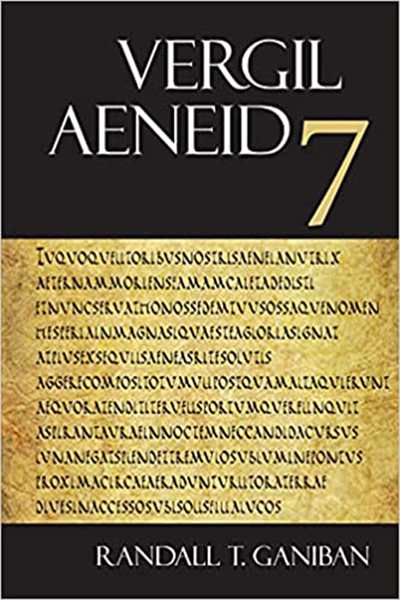
Book 7 of the Aeneid is not as well known as some of the others, which is a shame because it occupies a turning point in the structure of the Aeneid and in how we choose to see Aeneas. This edition, from a US publisher, is from a series that will cover all the books of the Aeneid for use ‘at the intermediate level or higher’. It has much to recommend it, but it is helpful to consider the wider context before focusing on this edition.
All teachers, whether at secondary or tertiary level, will have grappled with the problem of moving students from coursebook Latin on to unadapted original texts. The cognitive load on the student is huge – vocabulary (unknown words, known words with unusual meanings), syntax, periodic sentences, word order. It is a huge hurdle if students are to be helped to become independent and confident readers. The amount of help and the way it is presented are very important.
UK readers will be used to the series of editions of classical texts from Bloomsbury. Recent ones are very much geared towards the OCR exams (with the exception of Carter's two books with selections across all books of the Aeneid). They tend to be quite prescriptive in what the text ‘means’. There is also the Cambridge ‘Green and Yellow’ series, aimed at the undergraduate and graduate student. These need a confident, experienced Latinist, not one who needs much hand-holding. The current book occupies the middle ground under the confident and experienced hands of Ganiban.
The book has a general introduction to the Aeneid (which is repeated in each book of the series), a short (three-page) introduction to Book 7, appendices on metre and stylistic terms, an extensive bibliography, and an alphabetical list of vocabulary. Importantly, the text and related notes are presented on the same page, meaning that typically there are around eight lines of Latin at the top of each page. Ganiban divides Book 7 into three main sections (arrival in Latium; Juno and the outbreak of war; catalogue of the troops) each of which has a couple of sides introducing the content and themes of the section, together with a suggestion as to further reading. Subsections are made for blocks of text around 20–30 lines to signpost the content for the student. The combination of these help the student to keep track of the direction of travel of the narrative.
The Latin itself is in a good, clear font of a relatively large size. The notes are a little smaller, but still easy to navigate and the line references are easy to see. They offer a good balance, dealing with less usual meanings of vocabulary, grammatical help and explanations, quite a few glosses, explanations of names, comment on literary effects, intertextual references to themes and events elsewhere in the book and in other authors. Some commentaries like to explain features using a high degree of technical terms of grammar. This edition steers a middle course here: it judges well what a student who is building up experience in a language needs to understand in the current context. It is not afraid to gloss where this is easiest, but gives literal translations where this helps to show the interesting things that Virgil does with language. In short, Ganiban gives information to help the student get the basic meaning but then to appreciate the significance of what is written and how it is expressed. It encourages the student to see translation as only the first step in getting inside the text.
The production standards of the books are excellent, and it maintains a high level of accuracy of content.
This edition gives a very different impression of Virgil from Carter's recent selections (Bloomsbury 2020, reviewed in JCT issues 44 and 45). While Carter has the benefit of vocabulary lists on the page below the text, he gives the impression that a word has, at the most, two possible meanings. The notes on grammar aim simply to aid comprehension, but give no hint of the richness that Virgil offers the reader. The editions of three complete books of the Aeneid by Maclennan offer a closer parallel to this series but suffer from the disadvantage that the reader has to turn to a separate place in the back for notes rather than having them on the same page of the text. His notes tend to focus on the immediate context with less on the wider context and intertextual allusion.
I very much like what Ganiban adds in terms of thematic and intertext, on his references to current scholarship in the bibliography, and in his work on explaining vocabulary and the range of meanings. The latter is a key skill that we need to instil in students so they become less dependant on word lists and begin to understand how Latin writers used words creatively.
I have used four of the other books in this series at the University of Warwick for our second year ab initio language students. They all worked very well, providing a good level of support without presenting a two-dimensional view of the rich fare that Virgil offers the reader. The bibliography, in particular, is up to date and gives a wide overview of current issues in Virgilian scholarship. My teaching as well as my appreciation of the text was much enriched by this level of support.
The one thing that will count against this edition of Book 7 in the UK is the exam system: unless or until Aeneid 7 is set as a A level text, I doubt that it will have a place in schools. I would strongly recommend this series for anyone teaching Virgil to enrich their teaching and scholarship at A level and is certainly worth universities considering this as a required edition.

